2.1 Introduction to Innovation Methods in Design Processes
2.1.1 Introduction
This section provides theory on innovation processes and innovation methods for industrial design engineering. The theory will be illustrated by results of design cases with sustainable energy technologies that have been executed with various innovation methods by students.
Here, innovation will be considered as changes of product–market–technology combinations, and the theory will refer to this framework. In this Chapter, nine innovation methods that will be discussed in this book will be briefly introduced to the reader. These innovation methods are platform-driven product development (discussed in detail in Section 2.2), the Delft innovation model (discussed in detail in Section 2.3), TRIZ (theory of inventive problem solving) and technology road mapping (in Section 2.4 and 2.5), the design and styling of future products (Section 2.6), constructive technology assessment (Section 2.7) and the innovation journey (Section 2.8), risk diagnosing methodology (Section 2.9), and the multilevel design model (Section 2.10).
First, we would like to question what innovation is and discuss the setting of innovation in product design and engineering. Innumerable definitions of innovation are available. Their main correspondence in meaning is related to the concept of novelty. For instance, Webster's dictionary describes “to innovate” as to make changes or to introduce new practices. Von Hippel (1988, 2005) defines an innovation as anything new that is actually used, whether major or minor. And Rogers (2003) describes an innovation as an idea, practice, or object that is perceived as new by an individual or other unit of adoption.
Innovation in the context of industrial design engineering is represented in Figure 2.1.1 as an innovation flower involving the following five fields: technology, design and styling, human factors, marketing, and society. In Figure 2.1.1, technology refers to product technologies and materials, as well as manufacturing processes. Design and styling refers to the appearance of products and their image in the market. Human factors cover the user context of consumer products and the physical ergonomics. Marketing refers to market value costs and sales. Finally, the term society implies the field of policy and regulation and societal acceptance. We believe that all five components of the innovation flower are equally important to product development and the final success of a product. Therefore, in this chapter on innovation methods, we will position product development in the context of the innovation flower.
Figure 2.1.1 Innovation flower of industrial product design
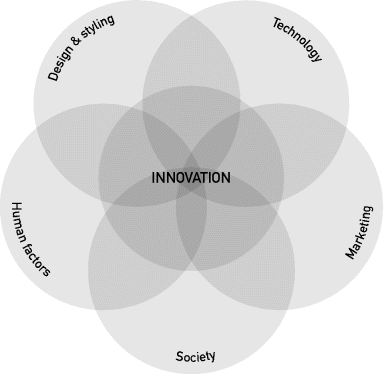
Industrial design methods (IDMs) play an important role in product development processes. IDMs convert market needs into detailed information for products that can be manufactured. IDMs vary in their approaches to problem solving. In technological design, design processes are generally viewed as heuristics. In other words, we assume that design goals can be defined by carefully describing a problem prior to formulating possible solutions to this problem. Through problem decomposition, the complexity of the problem is reduced. Next, the designer evaluates how solutions to subproblems can be merged into a solution composition that meets the design goals. The embodiment of the solution is a product.
A generally accepted approach toward this process is described in detail by Pahl and Beitz (1984) (Figure 2.1.2). It consists of four phases:
In the first three phases, product designers seek to optimize the working principle of a product. The last three phases involve optimizing the layout and form of a product. Thus, conceptual and embodiment design form the connecting links between technology, on one hand, and design and styling and ergonomics, on the other. Figure 2.1.3 shows in which phases the innovation methods that will be presented in this chapter can be applied.
Figure 2.1.2 Flow chart representing the basic industrial design method of Pahl and Beitz

Figure 2.1.3 Flow chart representing innovation methods presented in this chapter in the framework of the basic industrial design method of Pahl and Beitz (1984). RDM: risk-diagnosing methodology; CTA: constructive technology assessment

Theoretically, innovations improve product performance over time. Figure 2.1.4 shows the exponential nature of such growth, which has been widely documented throughout the history of human technology and is widely known as the S curve (Burgelman et al., 2004).
Figure 2.1.4 S curve of innovation
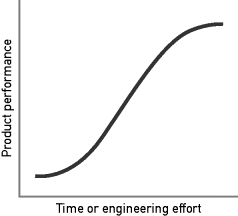
Innovation is related to technology development. Generally it is assumed that the more a technology is developed, the less innovative its applications are. Arthur D. Little (1981) distinguishes four types of technologies depending on their level of implementation in product development. Emerging technologies have not yet demonstrated clear product potential. Scientists discover emerging technologies in the course of explaining working principles. Next, packing technologies have demonstrated market potential and are the subject of ongoing research and development (R&D) to make them fit for applications. Organic electronics is an example of packing technology. Finally, the purpose is to embed the technology in products. Such key technologies may be patented. Technologies that have become common to all competitors – they are a commodity – are called base technologies.
Technologies that are on the threshold between what Little refers to as packing and key technologies can result in innovative product design. Namely, potential applications of technology are being assessed through R&D, and they are still in the process of being integrated into products. Figure 2.1.5 shows how both technological research and product design may contribute to innovations at this stage. On one hand, the development of promising technologies may initiate product design. On the other hand, problems with the design of products based on existing technology may stimulate further technological research.
Figure 2.1.5 Innovative products result from the conjunction of technology research and product design
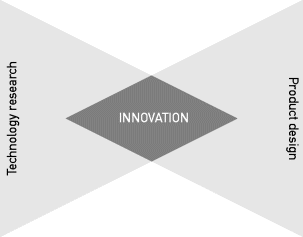
In this framework, Reinders et al. (2006, 2007, 2008, 2009) explored the relations between product design with existing sustainable energy technologies and the application of various innovation methods in the design process, as indicated in Figure 2.1.3. Based on these design experiences with about 70 teams of students, we can show many examples of product design with innovation methods in this chapter.
2.1.2 Platform-Driven Product Development
A product platform defines a set of related products, a so-called product family, that can be developed and produced in a time- and cost-efficient manner. Features of a product platform are modularity, connecting interfaces, and common standards (Halman, Hofer, and van Vuuren, 2003). By using a product platform, companies can reach different markets (and customers) with less effort than by developing separate products.
An example of platform-driven product development is shown for the case of a solar-powered street-lighting product, such as in Figure 2.1.6. In order to achieve large volumes with sufficient product variations in a time-efficient manner, several modules were selected from which different product families could be composed. As a consequence, the product platforms shown in Figure 2.1.7, called City Lighting or Road Lighting, can be implemented in different markets. For a detailed explanation about platform-driven product development, see Section 2.2.
Figure 2.1.6 A solar-powered street-lighting product, exploded view by Scholder and Friso (2007)
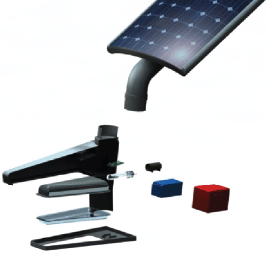
Figure 2.1.7 Product platforms of photovoltaic (PV)–powered street-lighting products consist of several modules from which different product families can be composed
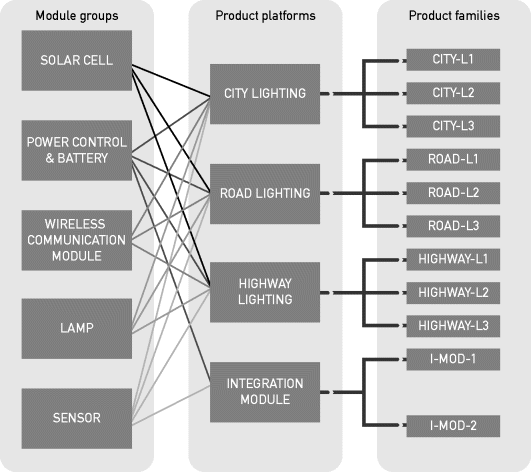
Figure 2.1.8 shows the effect of platform-driven product development in a matrix of customer value perception versus enabling technology. For instance, theoretically speaking for a manufacturer of gardening equipment, a fuel cell–powered blower would be a breakthrough product, enhancing its portfolio of conventionally powered equipment. Thus, the risk of integrating new hydrogen technology in products can be distributed over ongoing product development activities.
Figure 2.1.8 Product platform for gardening equipment, (B1) blower on hydrogen energy, (B2) blower with noise reduction system, (B3) blower standard, (C1) cutter with flexible drive shaft, (C2) cutter standard, (S1) chainsaw with automatic balancing system, and (S2) chainsaw standard
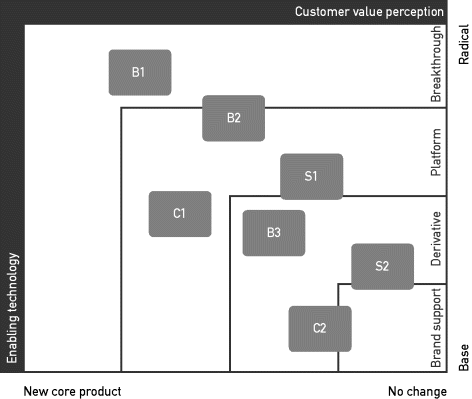
2.1.3 Delft Innovation Model
The Delft innovation model of Jan Buijs (2003), also known as the innovation phase model, aims to optimally combine the intrinsic value of technology with opportunities in the market. It consists of four phases: a strategy formulation stage, a design brief phase, a product development phase, and a product launch and use phase. For the purpose of product innovation, the strategy formulation stage, shown in Figure 2.1.9, is most important. A matrix of internal strengths of technology and external opportunities in the market results in many search ideas. Divergence, selection, and convergence of search ideas related to technology and markets lead to innovative technology–product–market combinations, the so-called search areas, or search fields.
Figure 2.1.9 Scheme representing the strategy formulation stage of the Delft innovation model
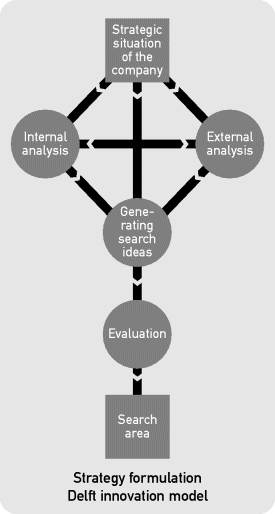
Search field information comprises the following topics:
- Subject: the relation of the idea to markets, product (groups), and services.
- Description: a short description of the direction of the idea.
- Strength: What are the basic strengths of the idea?
- Trends: To which developments in technology and markets does the idea connect?
- Needs: Which problem(s) will be solved by the idea?
- Size: An indication of the size of the market.
- Segmentation: Which subareas and differentiation of products can be foreseen?
- Stakeholders comprise parties involved such as competitors, experts, and consumers.
- Bottlenecks: Which problems – both internal and external – can be expected?
Next, information connected to these search fields can be inputted to the design brief stage. Again divergence, selection, and convergence can be applied to select search fields to be worked out further.
The creative process of the Delft innovation model is supported by visual collages and written mind maps. Figure 2.1.10 shows a communication device that has been developed by using mind maps. Mind maps of a fuel cell (Figure 2.1.11) and of lead user hikers (Figure 2.1.12) are combined to determine a suitable technology–product–market combination. For more information about this model, see Section 2.3.
Figure 2.1.10 Communication device for hikers with integrated fuel cells. Left: Front view. Right: Opened back view. Designed by Kyra Adolfsen and Benne Draijer

Figure 2.1.11 Mindmap of a fuel cell. Selected search fields in white
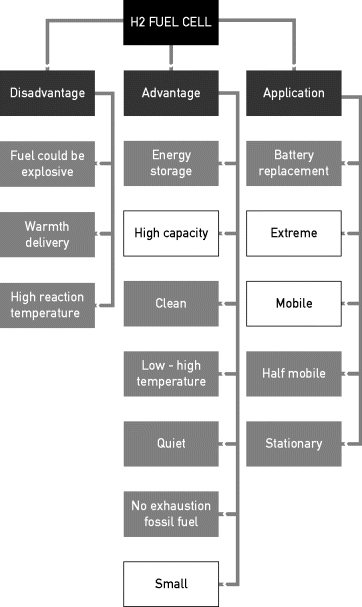
Figure 2.1.12 Mindmap of lead user hikers. Selected search fields in white
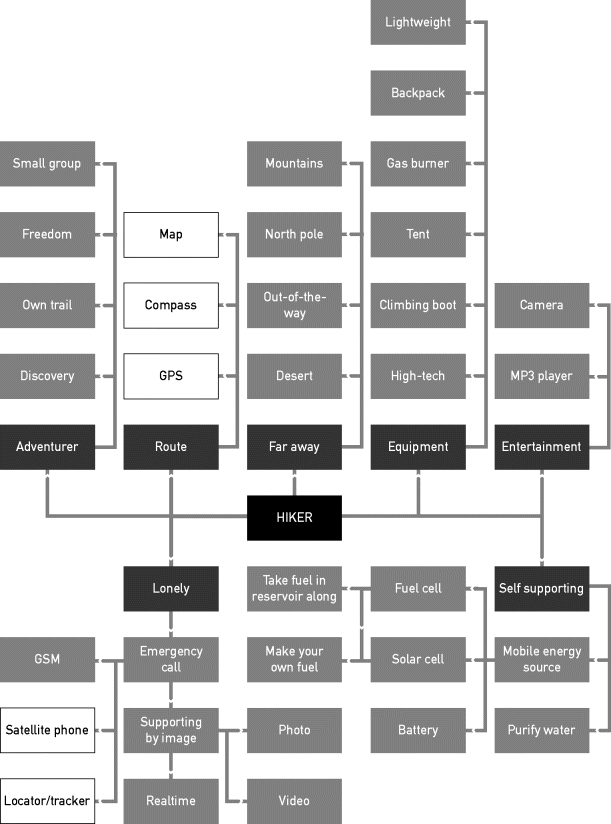
2.1.4 TRIZ
TRIZ is a Russian acronym meaning the theory of inventive problem solving (Altshuller, 1984). TRIZ can be applied to estimate the probability of technology developments. It is a comprehensive method based on long-term patent research leading to certain basic rules governing problem solving in product development.
Each trend of technology evolution demonstrates a line of a system's structural evolution with regard to changing its physical structure, space, time, energy, supersystem relations, and other parameters. Each trend contains a number of specific patterns, which are transitions that specify how a system should be changed to move from stage A to stage B of evolution. The trends are quite generic in nature, and exploring their applicability requires a combination of modern technologies that reside outside of the industry sector in which a product belongs.
Figure 2.1.13 shows in which fields TRIZ could improve product development. Since there are many diverse TRIZ trends, the method becomes complex. Therefore, software has been developed to make it easier to apply TRIZ. Section 2.4 gives an extensive overview of TRIZ.
Figure 2.1.13 TRIZ trends of technology evolution, from Souchkov (2005)
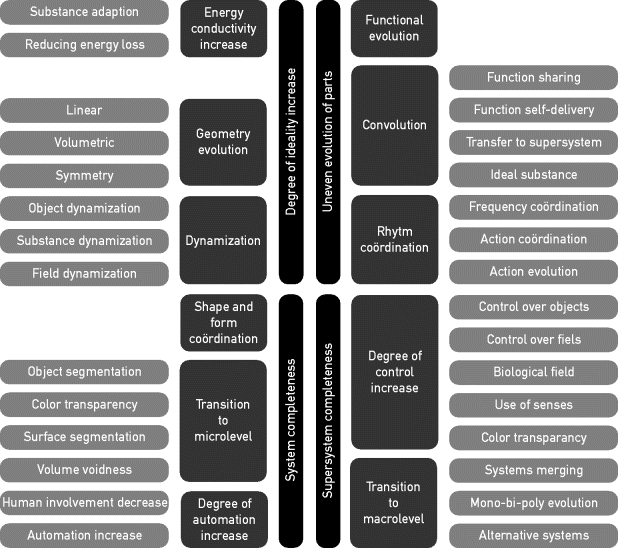
2.1.5 Technology Roadmapping
A technology roadmap (TRM) establishes a correlation between identified market needs and trends with existing and emerging technologies for a specific industry sector (Souchkov, 2005). Technology roadmaps usually cover 3–10 years and are used in strategic product planning, research planning, and business planning (Phaal, Farrukh, and Probert, 2001). Figure 2.1.14 shows an example of a TRM for the furniture industry. Theory and examples of applications of technology roadmapping will be provided by Section 2.5.
Figure 2.1.14 Technology roadmap for the furniture industry by Valeri Souchkov
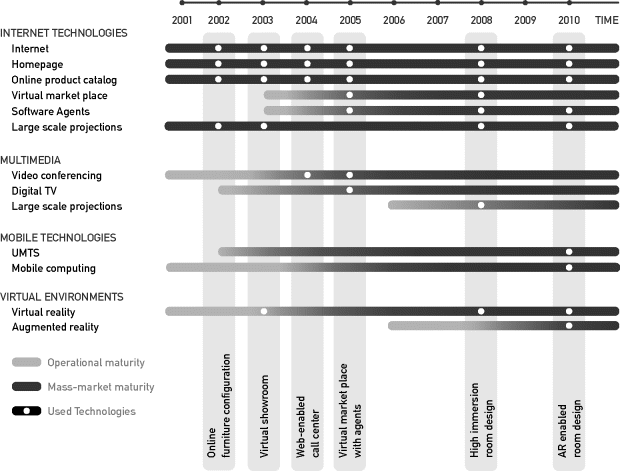
2.1.6 Design and Styling of Future Products
Design and styling are assets for technological innovation (Christensen, 1995). More specifically, cars, modern durables, and consumer products require a high degree of integration between functional and aesthetic aspects of design. Design is often regarded as purely aesthetic or superficial. Research by TNO (2005), however, has highlighted the crucial role played by design in the economy of the Netherlands and in product innovation. It was concluded that companies combining technological innovation with new product design increase their market share relative to other companies. It therefore seems likely that industrial designers will provide significant added value to products with new technologies.
A market of products with integrated technologies can be promoted by studying the image that potential users of a proposed product wish to project and designing the product so that it meets those aesthetic requirements. A method for developing an appropriate styling for innovative products is shown in Figure 2.1.15. It comprises the use of style elements from both associative and competing products.
Figure 2.1.15 Method for innovative design and styling based on characteristic style elements from associative and competing product by Stevens (2005)

Figure 2.1.16 shows a design for a diving lamp with integrated fuel cells. Technology is decisive in the high-end diving market, where users require long burning hours and reliability. In the larger market of so-called family divers, however, design and styling (see Figure 2.1.17) are more important. In Section 2.6, aspects related to the design and styling of future products will be further explained.
Figure 2.1.16 Diving lamp powered by fuel cells by Julia Garde and Annelies Brummelman
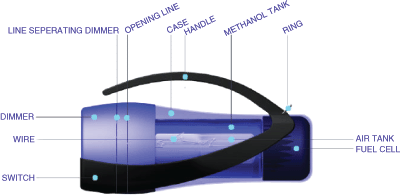
Figure 2.1.17 Design and styling of a diving lamp by diverging, categorizing, and converging associative and competitive style characteristics in two phases Drawing by Julia Garde and Annelies Brummelman
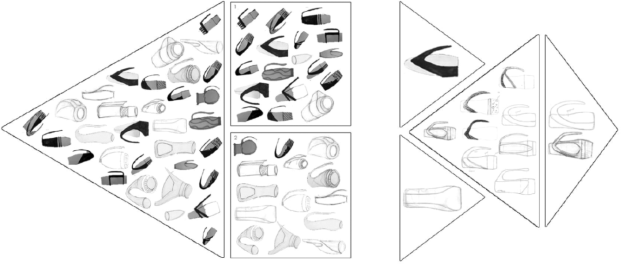
2.1.7 Constructive Technology Assessment
In innovation journeys, many actors play a role. New products must be promoted by manufacturers and retailers, must be approved by a competent authority in accordance with industry rules and standards, and must meet with acceptance from consumers. Constructive technology assessment focuses on these processes and how to improve them (Deuten, Rip, and Jelsma, 1997). The dynamics of technological development involve a series of exchanges between technology and society. Social projects such as those shown in Figure 2.1.18 foster the acceptance of new products by teaching people about the benefits of technology for society.
Figure 2.1.18 Fuel cell–powered rickshaw (Designed by Simon Brandenburg and Werner Helmich (2006))

In Asian metropolises, transportation has always been a difficult problem. Owing to outdated engine technologies, private taxies (referred to locally as rickshaws, tuk-tuks, bajajs, etc.) are a primary source of air pollution and noise. Because they require little power – about 5 kW – rickshaws could be an interesting application for proton exchange membrane (PEM) fuel cells. A positive social impact would result from the decrease of harmful emissions and increased comfort due to decreased noise. As a side benefit, PEM fuel cells could supply the rickshaws with electric power, enabling end users to operate air conditioning, stoves, and refrigerators from them. Moreover the rickshaw, as an icon of transportation cherished by many residents, might serve as a catalyst to accelerate social acceptance of fuel cell technology. In Section 2.7, the theory of CTA will be further explained.
2.1.8 Innovation Journey
In the case of technology-based product design, product development often follows certain patterns. By examining the so-called innovation journeys (Rip, 2005) of products in different fields, one may gain tools for assessing the potential innovation journeys of new products using new technologies or new situations of use; see also Section 2.8.
One pair of students used this approach to design an induction cooking device powered by fuel cells (Figure 2.1.19). They evaluated the evolution of technologies for cooking dinner, starting with plain fire and leading to the principles of electrical cooking. Comparing plain electrical elements, ceramic, halogen, infrared, and induction cooking, they found the last method most suitable in relation to customers' demands for an easy-to-use and lightweight cooking device. The black box in Figure 2.1.19 accommodates all electrical components, including a replaceable hydrogen cartridge, a fuel cell of 500 W, and an induction coil. The black box fits snugly into the cubical case, which serves as a protective shell during transportation. The device is operated by an ergonomic user interface.
Figure 2.1.19 Induction cooking device powered by fuel cells. Left: The product in use. Right: In compact carrying case (Designed by Rick Tigchelhoff and Wouter Haanstra)

2.1.9 Risk-Diagnosing Methodology
Companies must take risks to launch new products speedily and successfully. In this scope, risk-diagnosing methodology (RDM) aims to identify and evaluate technological, organizational, and business risk in product innovation (Keizer, Halman, and Song, 2002). This methodology, which will be explained in detail in Section 2.9, has been developed and applied at Philips and Unilever, and is fit for product development in diverse areas such as the automobile industry, printing equipment, landing gear systems, and fast-moving consumer goods such as shampoo and margarine. The risks evaluated by RDM are related to product family and brand positioning, technology, manufacturing, intellectual property, supply chain and sourcing, consumer acceptance, project management, public acceptance, screening and appraisal, trade customers, competitors, and commercial viability.
One pair of students applied RDM to a product platform of fuel cell–powered equipment, and drew the following conclusions:
- The main risk is acceptance of the new, unknown, fuel cell technology by users.
- Most risks related to the production, manufacturing, and distribution of the new product can be mitigated or eliminated by forming a joint venture with several stakeholders.
- A design process that involves the participation of end users can be used to create a higher degree of acceptance for new products.
